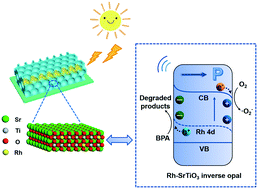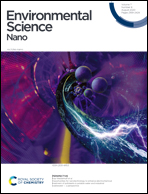Rh-Doped SrTiO3 inverse opal with piezoelectric effect for enhanced visible-light-driven photodegradation of bisphenol A†
Abstract
Coupling the piezoelectric effect of piezoelectric semiconductors with the photocatalytic technique is considered as a promising strategy for suppressing the recombination of photogenerated charge carriers. A new piezo-photocatalyst, a Rh-doped SrTiO3 inverse opal, was prepared by a hard-template method. Doping of photoactive Rh3+ played a significant role in improving the visible-light response ability and piezo-/photocatalytic activity of SrTiO3. In addition, the introduction of 3D ordered inverse opal structure was favourable for light harvesting. Co-excited by solar energy (visible light) and mechanical energy (ultrasonic vibration), the Rh-doped SrTiO3 inverse opal showed a significantly enhanced degradation rate of bisphenol A, which was 8.9 times higher than that of SrTiO3 nanoparticles under visible light only. The boosted piezo-photocatalytic efficiency was ascribed to the efficient separation of photogenerated electron–hole pairs under the acceleration of the built-in piezoelectric field in the Rh-SrTiO3 inverse opal, as confirmed by piezoelectric force microscopy (PFM). Therefore, this work provided a new insight into SrTiO3-based piezo-photocatalytic materials for efficient environmental remediation.



 Please wait while we load your content...
Please wait while we load your content...